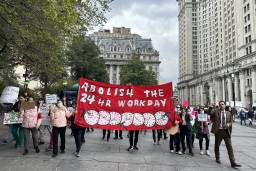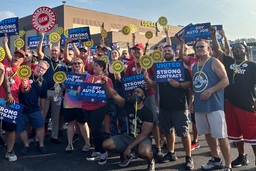Will government workers join the race to the bottom?
I was stopped dead in my tracks and felt a cold chill run down my spine while reading the current issue of The Atlantic. Its cover story is “The 14 3/4 Most Powerful Ideas of the Year,” which is a Top 10 list that makes fun of Top 10 lists (hence the 3/4).
Idea number 13 is the one that got me. It was written by The New York Times’ David Brooks and titled “Teachers are Fair Game.” As Brooks sees it, it is now open season for intellectually assaulting teachers. To be honest, Brooks aims mostly for the teachers unions. The result is yet one more mainstream media outlet joining the echo chamber claiming that teachers and their organizations are at fault for the poor state of education in America.
What I call the “blame the teacher” movement is smart politics for those on the right. It shifts public debate away from funding and economic equity issues to teachers on the frontline. In some ways it is like a Fordist speedup without the $5 day. Newly proposed policy would tie teacher salaries, merit pay, and even tenure to student test scores. The pressure is up, but, with diminished funding, resources are down.
Now, improving education is something everyone favors. It’s like democracy. But how one gets there is the million-dollar question. Can you improve education by putting increased pressure on teachers to raise classroom test scores in a time of declining public funding for education? We are about to see.
In my last Working ITT blog post, I bemoaned how we seem to hate “career” teachers as a culture. We love the young, idealistic missionary teachers. And we should: These recent college graduates are energized, smart and dedicated. But they have a short shelve-life, lasting a short time in the classroom before they are off to other careers. One could argue that even this is good, as the experience of a 2-3 years in a classroom changes them for the better.
Frankly, most teachers, it must be said, last only a short time in the classroom. The challenges are so great, the emotional costs as well as the salaries force many to rethink their career choices. Those that stay in education (I mean in the classroom) do not typically do so because they’re losers, or can’t find better jobs. They stay with it because they care and believe they can make a difference despite the hardships. It is precisely these teachers who have the nation’s eyes focused on them. I can almost hear the collective buzz in their ears from all this talk about them.
This public attention on teachers is part of a bigger public shift. There seems to be a major reset (to use a phrase from geographer Richard Florida) in the way we see public servants. It used to be that those that worked in public service were seen as civic. They worked hard, were valued and seemed to deserve their salaries and benefits. Up until the 1970s, public-sector salaries lagged far behind private-sector salaries. So state workers were working for less than market value.
But as private salaries for blue-collar and clerical jobs dropped and state salaries remained relatively stable, public-sector jobs looked better. Now, there is an attempt to downsize state payrolls, and get rid public servants. But rather than defending their service, we now see public servants as having it easy. They simply had what most American had, and lost.
What’s stopping many governors from this slash and burn are public-sector unions. So we need to see the current push against teachers as part of a larger push against public-sector unions. Rather than let each union deal with this shift, the labor movement should see the attack for what is, and coordinate a campaign to reverse this cultural shift.
…
Returning to David Brooks and teachers, we learn
…that a new cadre of reformers have come on the scene, many of them bred within the ranks of Teach for America. These are stubborn, data-driven types with a low tolerance for bullshit. The reform environment they find themselves in is both softhearted and hardheaded. They put big emphasis on the teaching relationship, but are absolutely Patton-esque when it comes to dismantling anything that interferes with that relationship. This includes union rules.…
Put simply, teachers unions stand between teachers and the public for better or for worse. Brooks points out some of the worse, but what of the better?
I’m a historian, so it’s important that I place this issue within its larger historical frame. Teachers unions have only been around for a little more than 100 years. They developed in large urban systems, such as New York City and Chicago. These systems were totally dysfunctional, patronage machines rife with politics. Professional educators joined together to advance professionalism over politics and patronage and to protect academic freedom.
These organizations were not like the trade unions of the day. They were much more professional societies, part of a period drive toward professionalization that historian Rober Weibe called “The Search for Order.” One hundred years ago teachers could be fired for all sorts of reasons, few related to the quality of teaching. Female teachers could be fired if they married, for instance.
Teachers were respected culturally, but it was not a profession. These early reformers demanded higher and better training for teachers as well as licensing. They cared about their students and fought to find ways to help them. But they also wanted decent wages and better working conditions and as professionals, they demanded some limited shared governance, or control over the educational mission (their classrooms). They did not see these aims as being in conflict. This professional focus has led to a more conservative style of unionism for teachers that the public and the right seems to have forgotten. They never felt fully comfortable as workers and their unions often walked that fine line between professional association and labor union.
Jump forward to the 1980s, when these unions were firmly established. As budgets were slashed and a call for accountability began to be heard, it was the teachers unions who mounted a campaign to retore public support for school funding and who also joined the reform efforts. Now, yes funding for schools helps their members. But, it is not just salaries. Stronger school budgets mean better support, newer books, smaller class sizes etc.
But teachers unions are now in a tough place. They seem to have lost their ability to claim they speak for “education” as they had in the 1980s. And if they can’t speak for public education, who can?
Today unions are at a crossroads. The majority of union members are public-sector workers. And these are precisely the same workers on the chopping block today. Unions need to find a better way to protect these workers than simply hiding behind the contract. The contract will protect workers in the short run, but in winning the battle they will lose the war.
We are losing an important aspect that informed public policy since at least the age of Herbert Hoover: The public should be held to higher standards than the private sector. My grandfather always told me it was a sad day when New Yorkers had to to pay to take public transportation. I remember him telling me if you pay, it ain’t public.
He was smart enough to know that his taxes paid for the fare. But he also understood that while income taxes were progressive, subway fare weren’t. He also knew that eventually the fares would just keep rising. He died some years ago, but I think he was right. What we need is a better sense of the public. If there are fewer good-paying jobs left, we all suffer.
Put simply: If federal, state and local government workers join the race to the bottom, we may well be doomed.








